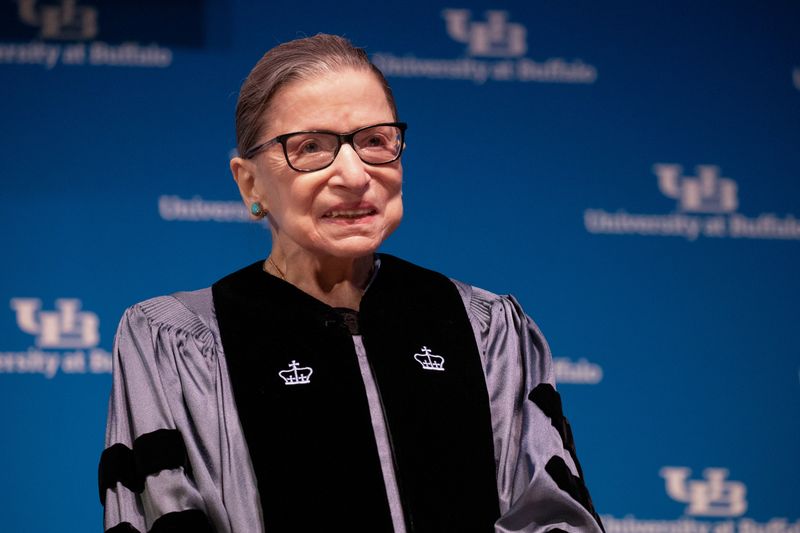(Reuters) – Justice Ruth Bader Ginsburg, at 87 the U.S. Supreme Court’s oldest member, said on Friday she is receiving chemotherapy treatment for a recurrence of cancer – the latest in a series of health issues – but indicated no intention to retire.
In a statement released by the court, Ginsburg said a periodic scan in February, followed by a biopsy, revealed lesions on her liver and she began chemotherapy on May 19. Oncologists said the information Ginsburg made public about her condition indicates she is experiencing a spread of pancreatic cancer, a serious development.
Ginsburg, the court’s senior liberal justice, said the treatment is yielding positive results and that she will continue it on a biweekly basis. She was previously treated for pancreatic cancer in 2019 and 2009.
“I am tolerating chemotherapy well and am encouraged by the success of my current treatment,” Ginsburg said.
“I have often said I would remain a member of the Court as long as I can do the job full steam. I remain fully able to do that,” Ginsburg added.
Ginsburg’s health is closely watched because a Supreme Court vacancy could give Republican President Donald Trump the opportunity to appoint a third justice to the nine-member court and move it further to the right. The court currently has a 5-4 conservative majority including two justices appointed by Trump – Brett Kavanaugh in 2018 and Neil Gorsuch in 2017.
Dr. John Marshall, chief of hematology-oncology at MedStar Georgetown University Hospital in Washington, and Dr. Diane Simeone, director of the Pancreatic Cancer Center at NYU Langone Health in New York, agreed that it appears her pancreatic cancer has metastasized. Neither has treated Ginsburg.
“What I’m interpreting from everything is that this is a recurrence of pancreatic cancer and it has spread to her liver,” Marshall said. “That’s a very normal process that’s common with pancreatic cancer.”
The average lifespan for a person with metastatic pancreatic cancer is 10 to 11 months, Simeone said. But Ginsburg’s positive response to the treatment suggests her prognosis likely will be more favorable than most, Simeone added.
CHEMOTHERAPY DRUG
The two doctors said the chemotherapy drug Ginsburg is receiving, gemcitabine, is the typical treatment for metastatic pancreatic cancer. Ginsburg said doctors first tried immunotherapy, but it proved unsuccessful.
Ginsburg also experienced bouts with lung cancer in 2018 and colon cancer in 1999.
Her most recent scan on July 7 indicated “significant reduction of the liver lesions” and no new disease, Ginsburg said.
“It means the treatment is working,” Marshall said, adding that usually means a “longer instead of shorter” survival.
Simeone suggested Ginsburg already has beaten the odds given that her original pancreatic cancer diagnosis came 11 years ago. On average, only 9 percent of newly diagnosed pancreatic cancer patients are living five years after diagnosis.
“I am optimistic based on how well she’s doing and her report that her liver lesions are shrinking that the chemotherapy may be quite effective at keeping her cancer under good control,” Simeone said.
On Wednesday, Ginsburg was released from Johns Hopkins Hospital in Baltimore after treatment for a possible infection, having undergone a procedure to clean a bile duct stent that was inserted last August. In May, she underwent non-surgical treatment for a gallstone that had caused an infection. Ginsburg said those two hospitalizations were unrelated to her cancer.
Ginsburg began receiving chemotherapy six days after the court completed hearing a round of oral arguments in cases by teleconference for the first time in its history in response to health concerns raised by the coronavirus pandemic. The court completed its nine-month term on July 9. She did not publicly reveal the treatment until Friday.
“Satisfied that my treatment course is now clear, I am providing this information,” Ginsburg said.
Ginsburg indicated she has been able to keep up with her work, including writing opinions in cases. “I will continue bi-weekly chemotherapy to keep my cancer at bay, and am able to maintain an active daily routine,” she added.
Ginsburg is the second-longest serving among the current nine justices behind Clarence Thomas, having been appointed to a lifetime post on the court by President Bill Clinton in 1993. She was the second woman ever named to the court, after Justice Sandra Day O’Connor was appointed 12 years earlier.
(Reporting by Andrew Chung; Editing by Will Dunham)


























